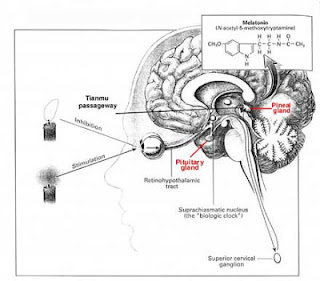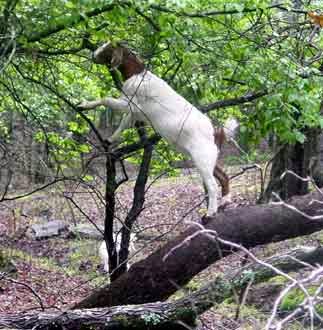In a famous 1978 episode of the TV sitcom, WKRP In Cincinnati, station manager Arthur Carlson releases turkeys from a helicopter to a waiting crowd below as part of a holiday publicity stunt. The birds crashed to the ground (off camera), as intrepid reporter Less Nessman described the carnage. You can find the entire episode here; it’s as funny now as it ever was.
This comedy had a 1940’s parallel in real life, when the
town of Yellville, Arkansas dropped Thanksgiving turkeys off the courthouse roof for several
years in succession, and then from low flying planes. They didn’t seem to have
any qualms about the flight problems of the domesticated turkey.
In contrast, the North and South
American wild turkeys would have survived the stunts. In the genus Meleagris, there are several species of wild turkey, and they can
and do fly short distances. In fact, they spend their nights perched in the low
branches of trees from Maine to Peru.
The Aztecs introduced the Spanish to Southern Mexican
turkeys (Meleagris gallopavo gallopavo),
who took them back to Europe in the 1520’s. The Spanish trade capital at the
time was Turkey, and from there turkeys spread all across the continent by the
1550’s. Therefore, the English called them turkeys, because they thought the
birds originated in Turkey.
The Meleagris g. gallopava
birds brought back to Europe were domesticated and became the eating turkeys of
today. They were bred for large breast muscles, and being raised in
domestication caused them to lose much of their flying musculature; the
domesticated turkey is flightless and mimics a bowling ball when released from
a helicopter.
We use the furcula as a sign of good luck, but for
domesticated turkeys it is just an unfortunate reminder that they used to have
a fighting chance at avoiding a gravy bath. It's ironic that breeding to increase
the size of their flight muscles is exactly why the domesticated turkey can’t
fly.
Over many generations, the domesticated turkey’s muscles
have become too big to allow it to fly and its legs have becomes shorter, so it
has a hard time running. In fact, they
are so large and cumbersome that they can’t even mate; they are inseminated
artificially in order to breed them further. Many have been bred for white plumage, so
that the small pin feathers left after plucking are harder to see.
But the noble turkey (Benjamin Franklin suggested the turkey
as our national bird) can trace its line back to about 1100 CE, with the
Spanish entering the picture about 400 years later. But new evidence suggests
turkeys were raised in captivity much earlier than either of these estimates.
A recent study based on excavations of Mayan ruins shows that as early as 300 BCE
there were male, female, and juvenile M.
gallopava within the settlements, and some reduced flight morphology
suggests that they had begun to be domesticated by that time. What is more, the
native turkeys in southern Mexico were M.
ocellata, not M. gallopava (from
northern Mexico and America), suggesting that trade in the animals with the
north had already commenced by this time period.
All this traveling suggests that by the time the pilgrims
landed in Massachusetts they were already familiar with the turkey, and its
inclusion in the first Thanksgiving feast was probably not a surprise to them.
There is no evidence that turkey was the served at the first Thanksgiving, but
it makes sense; both cultures were familiar with the bird. American Indians
even had tribes named for turkeys and believed that their feathers had mystical
powers; Central American Indians had turkey gods.
I find it a little odd that the turkey was revered as a god,
considering its looks – that is truly a face only a mother could love. It has
appendages and little growths everywhere. If a turkey spins its head around
when startled, it could slap itself silly! But as nature proves again and
again, everything has a purpose – or did.
The fleshy appendage around the head a throat of many bird species is called the wattle. In turkeys, the wattle hangs from under the beak and down the throat, but in pheasants it is located around the eye and cheek. Another name for this structure is the dewlap, and many animals have these. Even your grandmother might have a dewlap under her chin or upper arms!
The wattle is a mark of sexual
dimorphism in many birds (di =
two, and morph = shape). The males and females look different in species that
are sexually dimorphic. It is hypothesized that birds’ wattles are a form of
ornament for mate selection. A male with a larger wattle may be seen as more
fit and a may have more reproductive success. The hypothesis states that a
large ornament is energetically costly, so only the strongest, most disease
resistant males will be able to survive the cost of a large ornament and still live
to reproduce.
In terms of the female turkey, picking a male with
a bigger wattle would be the same as picking a male with stronger genes.
Indeed, a 2010 study in pheasants showed that there were different immune genotypes (MHC, major
histocompatibility complex) associated with wattle size. The functional
difference between the different MHC genotypes is not known, but they did show
a significant difference in the genotypes of males with larger wattles, and
those are the more highly preferred mates, so it may also represent stronger MHC types.
But domesticated turkeys don’t worry about selecting mates
or appearing healthy, all decisions are made by the breeder, so why do they
still have wattles? It may be because their breeding is anything but true
natural selection, but it may also be that the wattle has another function.
Being highly vascularized (having many blood vessels), the wattle can release body
heat by placing a large amount of blood close to the surface, thereby acting as
a physiologic control.
While many animals have wattles, and several different kinds
of fowl have caruncles, the turkey is the exception in that it is the only
animal with a snood. Its functions may be similar to those of the wattle and
caruncles, as they are much larger in males than in females. The snood length
in males is linked to testosterone levels, and males are more likely to dominate or steal food
from shorter snooded (just made up that word) males than long snooded (there it
is again) ones.
But turkeys are rarely served with the head intact, and eating them is what we are most interested in at Thanksgiving. Like chickens, turkeys have both dark and white meat. The difference in color is due to the makeup of the muscles and how they store and use energy.
The red meat of mammals and the dark meat of birds are
similar in that they contain high amounts of myoglobin. The muscles that have
myoglobin are for prolonged use; muscles used most of the time require lots of
oxygen to make lots of ATP. Myoglobin is to muscles cells what hemoglobin is to
red blood cells; it is a molecule that binds and holds oxygen. In the muscle
cell, the myoglobin will release the oxygen as needed to allow the muscle to
make more ATP and then use that ATP for contraction.
White meat, on the other hand, has much less myoglobin. Why? The muscles with white meat (like flight muscles) need energy in short bursts, perhaps to evade predation. To do this, they need less oxygen most of the time, but need lots of glucose some of the time. Therefore, they have less myoglobin but more glycogen (a storage form of glucose) so they can react quickly, rather than waiting for the blood to bring more glucose. The glycogen makes the cooked meat look white and glossy.
So, we have a big bird (did you know that Big Bird’s costume
is made of turkey feathers painted yellow?) providing us with a big meal on a
big holiday. Next week, we look at three stories of fungus-like protists. Can you believe that they are responsible for Irish priests in America and video game theory, and that they can be ranchers with hired cowhands?
For
more information or classroom activities, see:
Sexual
dimorphism –
Myoglobin
–
http://www.getbodysmart.com/ap/respiratorysystem/physiology/gases/myoglobin/animation.html

















